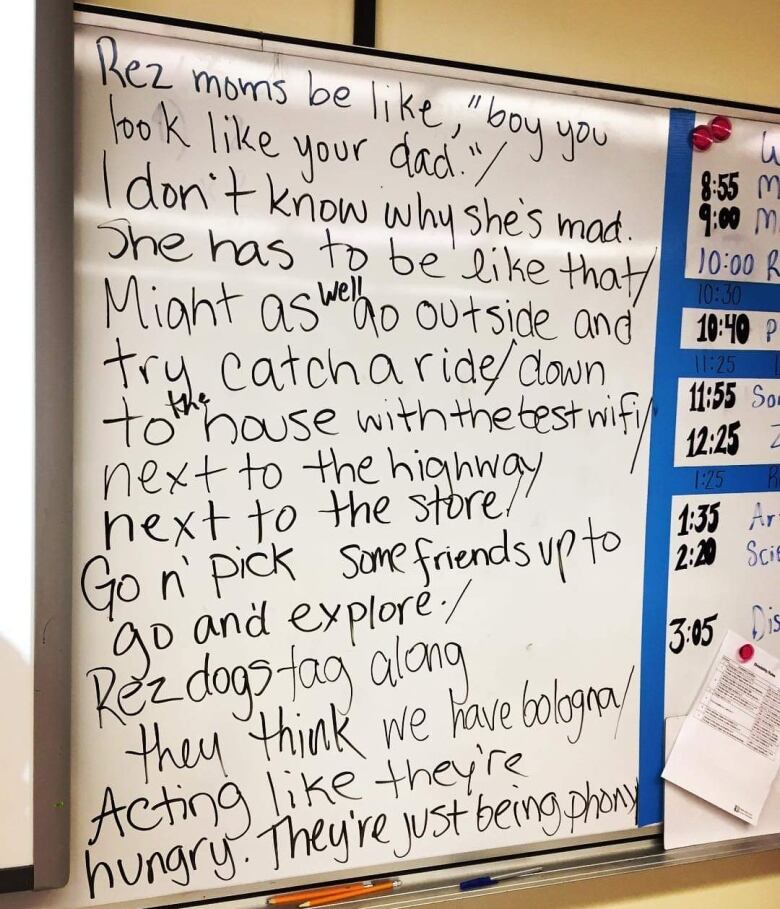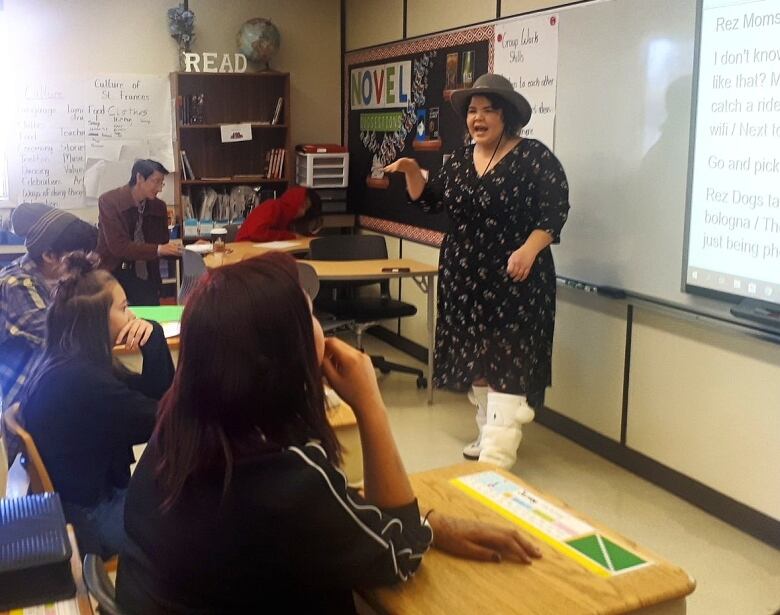'We're sounding like one': Poet uses hip hop for cultural connection in Indigenous classroom
Zoey Roy helping students in Saskatoon Cree bilingual school tell their stories

Rez moms be like, "Boy you look like your dad."
I don't know why she's mad. Why she gotta' be like that?
Zoey Roy walksa class of Grade 6 and 7 students at Saskatoon's St. Frances Cree Bilingual School through lines scrawled on a white board. She instructs the kidshow to put these lyrics to a hip hop beat and perform them for each other.
"What I notice about Indigenous young people is that they want to talk about, they want to write about their identity. They want to tell stories of who they are as children, who they are as people and what's familiar to them," said Roy, a spoken word poet and community educator.
Might as well go outside and try and catch a ride,
Down to the house with the best Wi-Fi.
Next to the highway, next to the store,
Go 'n' pick some friends up to go and explore.
The students are shy but still lively performing their song in front of an audience. One stands out: 11-year-old Hayden Paddy. She smiles, sings, and dances her way through Roy's class.
When asked why creating and performing her own material is important, she said "cause it will help them overcome what they're scared of doing."
Rez dogs tag along, they think we have bologna,
Acting like they'rehungry. They're just being phony.

Roy is teaching in St. Frances's "overflow" school. There were so many students enrolled at the first location they needed a second to accommodate everyone.
"I see a lot of poverty, a lot of them come from broken homes, of course. Alcohol, drugs is a big issue not only in the city, but reserves, too. That's just a barrier that we as teachers have to make a bridge with," said teacher Martine Bear.
Bear said she has to go the extra mile to help her students.
"I just take my students and other students as my own. I let them know I care and I'm always here for them. I let them know that they can trust me."
Bear said many of her students grew up in Saskatoon, or they leave the reserve andnever return. She said some are not connected to their roots, so exploring their identity and culture in Roy's classroom is crucial.
"A lot of them don't even know the basic protocol with ceremonies or they lose their basic kinship, so Ithink it's really important so they can learn andcarry on this knowledge. They can pass it onto their kids," Bear said.

"For a lot of my teenager years I felt really incomplete or insufficient as an Indigenous person. I never felt like I was enough until an elder told me one day, 'You're a perfect little Indian girljust the way you are.' Then I realized that I was enough and I want to convey that message to other Indigenous children and youth who are searching for their identity," said Roy.
As a Dene, Creeand Mtis woman from the Peter BallantyneCree Nation, Roy said using hip hop is a deliberate way to help studentsconnect to their writing.
"Hip hop comes from a place of oppression and that's something that we as Indigenous people understand. The challenges we face within our own selves, within our families, within our communities and within Canada: those are deep rooted and complex," said Roy.
"There has to be a source of joy unapologetically that we're able to celebrate ourselves ... Ido see it as a place for us to be genuine in our own storytelling practices."
By the end of the class, the students have their own song they wrote and are able to perform.
Roy stands at the front of the classroom and encourages her students to join in.
"I see you. I hear you. We're sounding like one. We're riding the beat. We know how to do this."












_(720p).jpg)


 OFFICIAL HD MUSIC VIDEO.jpg)
.jpg)



























































































